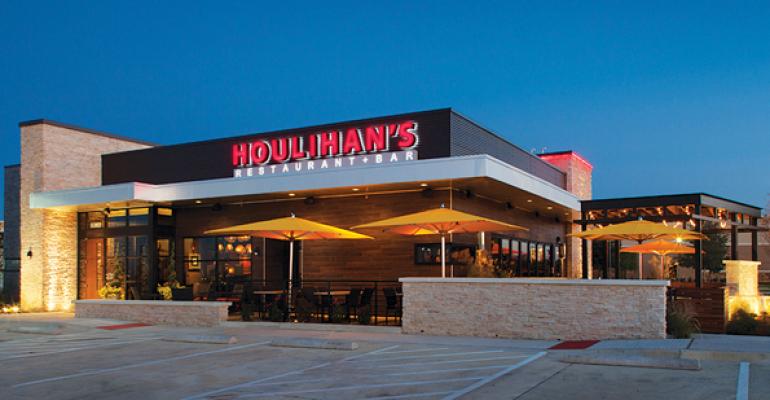
Houlihan’s Restaurants Inc. is seeing success with its test of a slimmed-down, dressed-up prototype — a changed spurred by a post-recession landscape “where we didn’t have any slack left in the equation,” according to Rob Ellis, chief financial officer and chief development officer of the Leawood, Kan.-based company.
The chain of nearly 100 upscale-casual restaurants tested the new building design in four markets over the past year, including a location near its home market in Overland Park, Kan. There, a newly built freestanding prototype saw a 24-percent sales increase in its most recent quarter, compared with sales a year earlier in an older unit across the street with the same customer base.
RELATED
• Houlihan’s introduces antibiotic-free chicken
• Houlihan’s revamps specials menu to fit seasons
• More casual-dining restaurant news
That Overland Park prototype reduced Houlihan’s square footage from 9,600 square feet to 5,600 square feet and took the box size from 290 indoor seats down to 183 seats. But the increased efficiency for building materials, utilities and interior seating helped Houlihan’s increase its cash flow in that unit by 54 percent before rent, compared to that of the older building a year earlier.
“We started down this path with the prototype for corporate development,” Ellis said. “We liked the results and think it’s something that increases the appeal for prospective franchisees.”
In Houlihan’s last rapid growth phase in the mid-2000s, the brand was maintaining an average weekly sales range between $60,000 and $65,000 needed to fuel unit expansion and maintain a good return on investment, “but there was no cushion if sales came in at $55,000 a week,” Ellis said. “We had to open every restaurant and have it perform optimally.”

The prototype restaurants have been able to generate an equal or greater annualized volume than the average unit volume for the old restaurant design, he added. One big reason is the re-engineered seating arrangements that allow for more two-tops.
“Even when we were on a wait on a busy Saturday night, our old building was more than half-empty because we had a mismatch between party sizes and available tables,” Ellis explained. “We were seating two people at four-tops, so there were a lot of unutilized seats.”
Though Houlihan’s prototype engineered much lower preopening costs and operation costs in order to maximize profitability, the brand still did not skimp on modern design elements common in upscale-casual restaurants, such as fireplaces, original artwork on the wall and an open kitchen, Ellis said.
“We shifted our investment in the building from things above the guest’s eye level to the things that are more part of the experience,” he said. “Tabletops, artwork and fabrics were where we spent the money.”

The brand also ditched the racetrack bar for a new bar against the wall, which freed up more square footage for seating in the dining room. Moving the bar also helped delineate parts of the restaurant and helped move away from a louder, more frenetic atmosphere that comes from centrally locating the bar in casual-dining restaurants, Ellis said.
“The energy levels can be different, so we like the bars separate from the dining room,” he said. “Part of our decision was to have the bar feed out onto the patio space.”
The prototypes feature about 75 seats on the patio with an outdoor fire pit, and windows between the bar and patio can be thrown open in favorable weather.
In all, investment costs for the new prototype will run between $1.4 million and $1.8 million for a conversion or remodel, and between $2.4 million and $2.7 million for a new build. Houlihan’s is looking to build between 10 and 15 locations per year between company-owned and franchised locations combined in its existing markets.
According to Nation’s Restaurant News’ Top 200 census, Houlihan’s had systemwide sales of $225.7 million for the fiscal year ended in September 2013, a decrease of about 3.7 percent from a year earlier.
The chain operates 36 company-owned restaurants and franchises another 47 Houlihan’s locations, in addition to 15 company-owned specialty restaurants like Bristol Seafood Grill and J. Gilbert’s Wood-Fired Steaks & Seafood.
Contact Mark Brandau at [email protected].
Follow him on Twitter: @Mark_from_NRN

